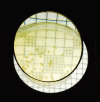In vitro assessment of photocatalytic titanium oxide surface modified stainless steel orthodontic brackets for antiadherent and antibacterial properties against Lactobacillus acidophilus
- PMID: 22007663
- PMCID: PMC8903869
- DOI: 10.2319/021111-101.1
In vitro assessment of photocatalytic titanium oxide surface modified stainless steel orthodontic brackets for antiadherent and antibacterial properties against Lactobacillus acidophilus
Abstract
Objective: To assess the antiadherent and antibacterial properties of surface modified stainless steel orthodontic brackets with photocatalytic titanium oxide (TiO(2)) against Lactobacillus acidophilus.
Materials and methods: This study was done on 120 specimens of stainless steel preadjusted edgewise appliance (PEA) orthodontic brackets. The specimens were divided into four test groups. Each group consisted of 30 specimens. Groups containing uncoated brackets acted as a control group for their respective experimental group containing coated brackets. Surface modification of brackets was carried out by the radiofrequency (RF) magnetron sputtering method with photocatalytic TiO(2). Brackets then were subjected to microbiological tests for assessment of the antiadherent and antibacterial properties of photocatalytic TiO(2) coating against L acidophilus.
Results: Orthodontic brackets coated with photocatalytic TiO(2) showed an antiadherent effect against L acidophilus compared with uncoated brackets. The bacterial mass that was bound to the TiO(2)-coated brackets was less when compared with the uncoated brackets. Furthermore, TiO(2)-coated brackets had a bactericidal effect on L acidophilus, which causes dental caries.
Conclusion: Surface modification of orthodontic brackets with photocatalytic TiO(2) can be used to prevent the accumulation of dental plaque and the development of dental caries during orthodontic treatment.
Figures










Similar articles
-
Effects of titanium oxide coating on the antimicrobial properties, surface characteristics, and cytotoxicity of orthodontic brackets - A systematic review and meta analysis of in-vitro studies.J Oral Biol Craniofac Res. 2023 Sep-Oct;13(5):553-562. doi: 10.1016/j.jobcr.2023.05.014. Epub 2023 Jun 24. J Oral Biol Craniofac Res. 2023. PMID: 37409325 Free PMC article. Review.
-
Antiadherent and antibacterial properties of stainless steel and NiTi orthodontic wires coated with silver against Lactobacillus acidophilus--an in vitro study.Prog Orthod. 2015;16:40. doi: 10.1186/s40510-015-0110-0. Epub 2015 Nov 17. Prog Orthod. 2015. PMID: 26576557 Free PMC article.
-
In vitro assessment of stainless steel orthodontic brackets coated with titanium oxide mixed Ag for anti-adherent and antibacterial properties against Streptococcus mutans and Porphyromonas gingivalis.Microb Pathog. 2017 Nov;112:190-194. doi: 10.1016/j.micpath.2017.09.052. Epub 2017 Sep 29. Microb Pathog. 2017. PMID: 28966064
-
Antimicrobial effect, frictional resistance, and surface roughness of stainless steel orthodontic brackets coated with nanofilms of silver and titanium oxide: a preliminary study.Microsc Res Tech. 2017 Jun;80(6):599-607. doi: 10.1002/jemt.22835. Epub 2017 Feb 9. Microsc Res Tech. 2017. PMID: 28181353
-
Use of Antimicrobial Silver Coatings on Fixed Orthodontic Appliances, Including Archwires, Brackets, and Microimplants: A Systematic Review.Med Sci Monit. 2024 Jun 6;30:e944255. doi: 10.12659/MSM.944255. Med Sci Monit. 2024. PMID: 38843112 Free PMC article.
Cited by
-
Evaluation of the cell viability and antimicrobial effects of orthodontic bands coated with silver or zinc oxide nanoparticles: An in vitro study.Korean J Orthod. 2023 Jan 25;53(1):16-25. doi: 10.4041/kjod22.091. Korean J Orthod. 2023. PMID: 36696956 Free PMC article.
-
The relationship between substrate morphology and biological performances of nano-silver-loaded dopamine coatings on titanium surfaces.R Soc Open Sci. 2018 Apr 11;5(4):172310. doi: 10.1098/rsos.172310. eCollection 2018 Apr. R Soc Open Sci. 2018. PMID: 29765680 Free PMC article.
-
Effects of titanium oxide coating on the antimicrobial properties, surface characteristics, and cytotoxicity of orthodontic brackets - A systematic review and meta analysis of in-vitro studies.J Oral Biol Craniofac Res. 2023 Sep-Oct;13(5):553-562. doi: 10.1016/j.jobcr.2023.05.014. Epub 2023 Jun 24. J Oral Biol Craniofac Res. 2023. PMID: 37409325 Free PMC article. Review.
-
Functional Coatings for Orthodontic Archwires-A Review.Materials (Basel). 2020 Jul 22;13(15):3257. doi: 10.3390/ma13153257. Materials (Basel). 2020. PMID: 32707959 Free PMC article. Review.
-
The effect of nitrogen-doped titanium dioxide-modified stainless steel brackets on Streptococcus mutans.Angle Orthod. 2022 May 1;92(3):396-401. doi: 10.2319/062521-510.1. Angle Orthod. 2022. PMID: 35072710 Free PMC article.
References
-
- Balenseifen J. W, Madonia J. V. Study of dental plaque in orthodontic patients. J Dent Res. 1970;49:320–324. - PubMed
-
- Gorelick L, Geiger A. M, Gwinnett A. J. Incidence of white spot formation after bonding and banding. Am J Orthod. 1982;81:93–98. - PubMed
-
- Årtun J, Brobakken B. Prevalence of caries and white spot lesions after orthodontic treatment with multibanded appliance. Eur J Orthod. 1986;8:229–234. - PubMed
-
- Eliades T, Eliades G, Brantley W. A. Microbial attachment on orthodontic appliances: I. Wettability and early pellicle formation on bracket materials. Am J Orthod Dentofacial Orthop. 1995;108:351–360. - PubMed
-
- Menzaghi N, Saletta M, Garattini G, Brambilla E, Strohmenger L. Changes in the yeast oral flora in patients in orthodontic treatment. Prev Assist Dent. 1991;17:26–30. - PubMed
MeSH terms
Substances
LinkOut - more resources
Full Text Sources
Other Literature Sources
Medical

